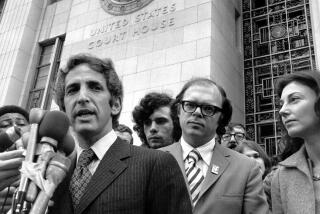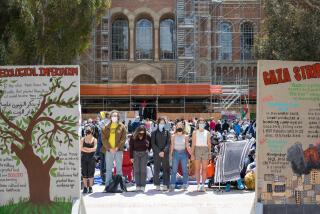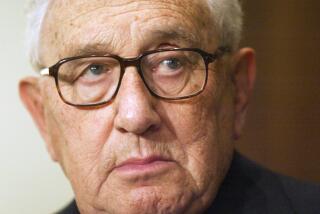Kissinger Phone Conversations Offer View of Nixon Years
COLLEGE PARK, Md. — The political and diplomatic morass brought on by the military misconduct was getting worse by the day. U.S. soldiers, fighting a distant war amid growing opposition to the conflict at home, faced prosecution for their role in horrific abuse. And the photographs of the abuse were so upsetting that the secretary of Defense advised the president’s national security advisor not to view them because “they’re pretty terrible.”
Memoranda and transcripts of telephone conversations conducted more than three decades ago by Henry A. Kissinger, and released Wednesday by the National Archives, show that senior Nixon administration officials discussed how they should deal with what was clearly about to become a public relations disaster -- the 1968 massacre of Vietnamese civilians by U.S. troops in the village of My Lai. They were angered by the photos, considered ways to suppress them, and honed their argument that they had begun an investigation of the abuse.
The 20,000 pages of documents, which were held at the Archives’ records center at the University of Maryland, include transcripts of conversations Kissinger conducted from President Nixon’s inauguration on Jan. 20, 1969, until Aug. 8, 1974, when the administration was brought to an end by the Watergate scandal. The conversations covered everything from casual chats about women on Kissinger’s arm to the inability of Nixon to take a call from the British prime minister because he “was loaded.”
The documents are based on summaries compiled by secretaries who listened on extension phones and made notes to produce verbatim accounts. Kissinger began the practice as national security advisor and continued it when he became secretary of State in 1973.
Putting the best face on the losing effort in Vietnam was the subject of many conversations. Kissinger reached out to columnists, entertainers (Bob Hope, for one), peace activists (one of whom, John F. Kerry, is now running for president), and politicians (Gov. Ronald Reagan of California among them) as he sought to manage public opinion.
In a conversation with Secretary of Defense Melvin R. Laird on Nov. 21, 1969, Kissinger sought information about the My Lai case. According to a summary of the conversation, Laird asked Kissinger if he had seen pictures of the massacre. Kissinger said he had not, then asked whether he should. Laird, as summarized by a secretary, said that he “might as well not. They’re pretty terrible.”
In any case, Laird said, the atrocity, which occurred before Nixon’s inauguration, “didn’t happen in our watch.” They then discussed whether the pictures could be impounded, but Laird said they had already been published.
Summarizing Laird’s comment, the memo, using “L” to designate Laird, said: “L said about a game plan, he’s like to sweep the whole thing under the rug, but you can’t do that.”
The documents show numerous examples of Kissinger’s efforts to shape public opinion: As defeat piled upon defeat in Vietnam, he instructed White House Press Secretary Ronald Ziegler to “say we have achieved essential objectives.”
Hundreds of conversations were held with journalists -- from discussions with State Department reporters to a gushing conversation with Katharine Graham, publisher of the Washington Post, and a flattering chat with Sally Quinn, star reporter of the paper’s Style section.
At other times, Kissinger spoke with striking candor: Told of a plan by Sen. Jacob K. Javits, a liberal New York Republican, to take the administration to task for being too tough on Israel, Kissinger says: “He’s right, of course.”
When Vice President Spiro T. Agnew asked him, “What the hell are we doing with the Chinese?” Kissinger replied: “We are playing a game with the Russians and the Chinese.”
He was, at the time, about to embark on a secret trip to China, although he kept his plans from some of the most senior officials with whom he worked.
Kissinger’s familiar relationship with the longtime ambassador from the Soviet Union, Anatoly Dobrynin, was apparent in their numerous conversations. Their dialogue demonstrated the extent to which Kissinger made personal relationships central to his diplomacy.
Dobrynin: “I heard that you were sitting with a very nice girl ... and I guess I have her picture?”
Kissinger: “Oh, yes?”
Dobrynin: “In the calendar. I think she was on this Playboy calendar.”
Kissinger: “Oh-h-h-h-h, you’re a dirty old man.”
Dobrynin: “... she’s a real nice girl.”
Kissinger: “... she’s very attractive. I hope she isn’t a nice girl.”
Kissinger then invited the ambassador to a meeting.
“OK, 5:30, usual place,” Dobrynin said.
Reviewing the documents, Thomas Blanton, director of the National Security Archive, a nonprofit research institute at George Washington University whose lawsuit brought about the release of the papers, said that working in that manner with the Soviets “was the signature foreign policy mode of the Nixon-Kissinger years, a back channel to the No. 1 adversary.”
Nixon and Kissinger enjoyed a comfortable familiarity, speaking throughout the day and into the evening.
They talked about media coverage and individual reporters (“Hell, if it weren’t for the hysteria that the media engender, we’d be in good shape,” Kissinger told the president during one particularly difficult period of the Vietnam War in 1971). They discussed military tactics (at one point, they bragged about the tons of bombs being dropped on Vietnam). They considered how to encourage supporters (Nixon advised Kissinger to tell Los Angeles Mayor Sam Yorty, “Look, you’re on the right track, boy, don’t lose your nerve. But things are coming out OK.”)
And, said Blanton, “they wiretapped each other.”
Nixon’s tapes -- revealed in 1973 during the Watergate investigation -- were running. Kissinger’s secretary was taking notes of what the president said. And, it turned out, H.R. Haldeman, Nixon’s chief of staff, was at times monitoring Kissinger’s calls through a line in his own White House office.
Kissinger, who now heads the foreign policy consulting firm that bears his name, was at the center of nearly every major event on the world stage during that period: the efforts to end the Vietnam War, arms talks with the Soviet Union, secret diplomacy that brought about Washington’s opening to China -- and the upheavals of the Middle East, including the 1973 Yom Kippur War.
On Oct. 11, 1973, as that conflict was raging, British Prime Minister Edward Heath called seeking a conversation with Nixon. Brent Scowcroft, then a senior Kissinger aide and later President George H.W. Bush’s national security advisor, conveyed the request to his boss.
“Can we tell them no?” Kissinger asked. “When I talked to the president, he was loaded.”
More to Read
Sign up for Essential California
The most important California stories and recommendations in your inbox every morning.
You may occasionally receive promotional content from the Los Angeles Times.










